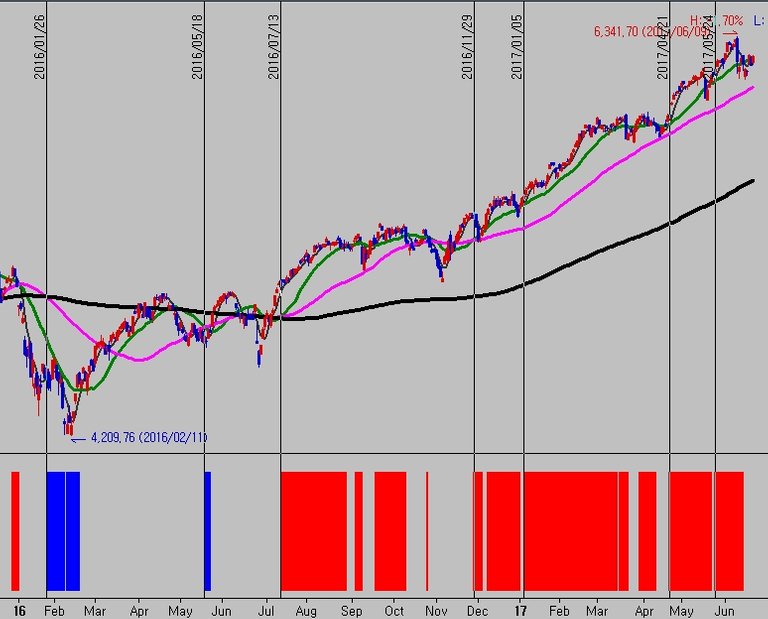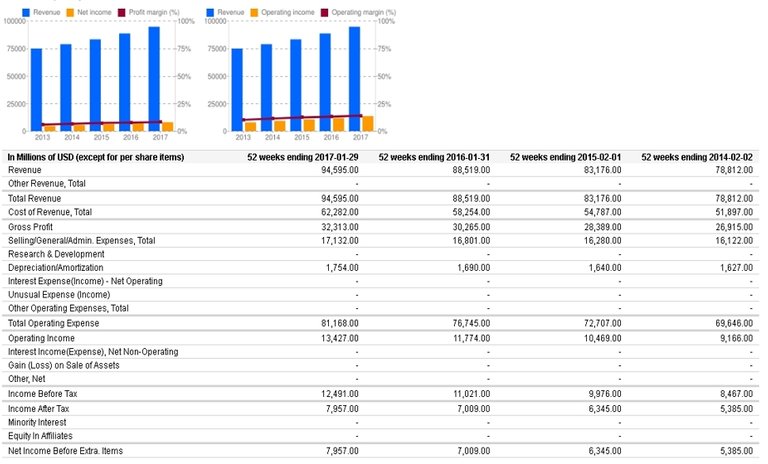Hello~ steemians. I'm @valueup. After the anguish of picking a topic for first posting(using English), I decided to write about the "stock" within my circle of competence.
Especially for the beginner, you have to achieve these 3 rules to avoid an embarrassing loss. Also, if you bought some stocks already, investigate those again in terms of these rules! With my whole heart..
1. Trend
Meaning : Just think it as "the law of inertia" which keep moving in a straight line. Up or Down. Simply going through with the previous direction => That means "admitting" the present power at a present time. Keep going is more easier than turning back or around. In a common sense, If some asset is going up recently, of course, the present asset price should be higher than the past. So mathematically, "the recent average number is higher than the past average number = The trend is going up"
Picture: Aesthetically, The shape of up-trend is "The direct array of 3 average lines+ above on super long term ". Main Condition is that "5 days(1 week) moving average >= 20 days(1 month) moving average >= 60 days(3 months, same as one quarter accounting period) above on Super long term moving average calculated by the period of 240 days
(20days*12month=1year)" The below red marked scopes on the NASDAQ daily chart are the periods qualified by the condition which is true up-trend with a shape of 5ma>=20ma>=60ma>=240ma.
From this point of view, The NASDAQ entered into the red phase at 21st April and 24th May recently. And then the market has been trending upwards. It couldn't be happen at any blue phases which have the inverse arrays of 5mA<20ma<60ma<and 240 ma.
Absolutely in the investment of ordinary shares, buying stocks at the beginning of the red timeframe has much advantages than at a blue or gray zone to make profit and avoid loss. This is the first essential rule of investment, "Trend"
2. Disparity
Meaning : Just think it as "the law of gravity". Here the central axis which drags an apple down from the sky to the earth is Moving Average line => The warning period is a timeframe that previous trend's strength is gone. In a common sense, stocks are not going up or down forever. Too rapid rise and drop needs a certain time period to get new power for keeping going the same way or a dramatic inverse way. Logically explaining principle is that "The gap between a stock price and moving average line is too high = required to take a rest for expanding the present trend or for making the opposite trend."
Picture : Aesthetically, The scene of warning disparity is "The price divided by moving average line is, statistically, at some high level " The average line to measure disparity is used by the numbers of 60 days or 240 days, meaning that 1 fiscal period,3 months(60 trading days),or 1 year(240 trading days) fiscal standard could represent certain trend fundamentally from a company's profit change.
Also high disparity means that the price is enough high to sell stocks by some smart groups bought before rising. So, newbies must be careful to buy it at high disparity, or consider to short selling.(But strongly recommend just taking a rest to reentry a market as buying position. Cause, very often, shortselling position pretending to be smart could make your life be short!)
Buy it at the beginning of the trend and make profit by selling it at high disparity level, statistically. And wait for next trend, or try to find another new trending one.

The NASDAQ is on the red zone, up-trend, now. But The disparity(price/60ma), marked by pink line below, peaked around 105.3 at 2nd June. This disparity number was very close to 21st Feb. 2017's disparity and slightly under 28th June 2016's.
In a word, The 2nd June's gap between price and 60 moving average line was enough high similarly to the levels of previous times. So, After the present pausing time, the up-trend would be expanding, but, the smart group that bought before want to make profit by selling it. So, if you are just interested in stock market and got open new stock account seeing the news that market made new high level, then calmly take a breath to avoid a thorny path. Market always open and live longer than one human.
The "Disparity" which indicates the degree of greedy and overheating is 2nd essential rule of investment to realize a profit and prevent loss beforehand.
3. Earnings (+cash flow)
Meaning : Fundamental elements as "Point of generating power"and dominate "Directional nature". Stock is basically one of pillars to support capitalism system by sharing the company's profit between shareholders and the owners. The multiple of price to intrinsic value (earning and cashflow,), the course of earning's up-down ,and the degree of spreading out the profit to shareholders determine how fast stock price entry into the direct array of red zone(Rule1. Trend area) and how long keep the buying territory,bull market.
Picture : Mathematically presented by "PER, PBR, EV/EBITDA" , "EPS Growth, Operating Profit Growth" and "Dividend Payout Ratio, Dividend Yield ratio". Need more specific explanation each figure, but briefly described, it is the answer against the question that "Is the company going to make earning more and share profit by paying out to investors?"
Of course, the ideal company to invest in should have a price under the intrinsic value, show nice growth, and give touching dividends. In the real investment world, however, it is rare to find out the stock which possesses both high growth rate and the cheap price.(Because of quick reflection of future growth to high price). And also the company with high dividend yield mostly shows low-growth rate of profit.
So, simply focusing on the point that "Stably, revenue and profit keep going onwards and upwards or not" is wise way to resolve the dilemma of fundamental analysis. After being aware of upper fundamental indicators, then you should answer the question "At least, Isn't this company going to bankruptcy due to abundant of cash and profit, now. right? Also, Is this growing?!
(In every area, especially in investment world, hard study and practice are indispensable to make money. The enemies are well-trained UFC Champions and we are just fledgling with vague greed. But both on the same squared ring. Watch Out!)

- This is the financial table of Home Depot, from 2013 to 2016, shows sustainable growth of revenue and profit (In fact, from the the former to 1Q 2017) without 1 year exception of development. In this kind of company's investment, according to the essential Rule No.3, no dissent from sustainable growth of profit and cashflow. So if invested in the sock only at the beginning of red up-trend period(Rule No.1), also qualified by not too high disparity(Rule No.2), have made money consistently.

- Synthetically with the combination of Rule No.1 Trend, NO.2 Disparity, NO.3 Earnings, we could make a profit comfortably(The suitable stock is not too many) To future or present investor, I suggest to study and achieve these rules of combination sincerely ~ : D
Epilogue...
Phew~ : Barely ended up my first writing. Tried to, melted with my whole experience, deliver in easy way for beginners, also with hope win the sympathize from existing investors.
It was not easy work. But thanks to this work, I reestablished my rules. To the senior steemians' awesome columns, You are great! I will try to write more like you. Please, with lovey rebuke and affection, read my next writings. And don't forget to up-vote and follow if this post was interesting to you. (: D) Thank you..
(P.S#1 If you want to know more about me, this is greeting 5days ago ^^;;
P.S#2 Suddenly being curious about the financial data of growing 'steemit'.. See you~)

Hey @valueup, nice first post! I think you describe the basic trend variables very well! I think you covered some nice topcis which adds value to the article you read from me :) Great job!
Thanks @patcher. Still I need to study more and think deeply. Let's keep in touch~ :D
thank you for sharing
Thanks for you, @enomujjass~ :D
Vote and I vote bro
Thnaks~@joeelqc1 bro~ :D.
방갑습니다 !! ㅎㅎㅎ 잘보고갑니다 꾸벅
아이구~ 이런 미흡한 글을.. 감사합니다~^^
This post received a 0.9% upvote from @randowhale thanks to @valueup! For more information, click here!